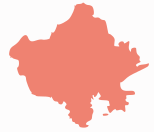|
Bundi
Bundi is a town in the Hadoti region of Rajasthan state in northwest India. It is of particular architectural note for its ornate forts, palaces, and stepwell reservoirs known as baoris. It is the administrative headquarters of Bundi District. Bundi has many temples, so it is called "Chhoti Kashi" (Little Varanasi).[citation needed] GeographyThe town of Bundi is situated 35 km from Kota and 210 km from Jaipur. It is located at 25°26′N 75°38′E / 25.44°N 75.64°E and an average elevation of 268 metres (879 feet). The city lies near a narrow gorge, and is surrounded on three sides by hills of the Aravalli Range. A substantial wall with four gateways encircles the city. It is served by Bundi railway station on Kota-Chittorgarh rail line. Bundi is also known as "Choti Kashi" as there are many old temples in the city, which has been built by kings at their reign.[citation needed] Climate
DemographicsIn the 2011 Indian census,[3] Bundi had a population of 1,03,286. Males constitute 52% of the population and females 48%. Bundi has an average literacy rate of 67%, higher than the national average of 59.5%; with male literacy of 75% and female literacy of 57%. 14% of the population is under 6 years of age. History Stone Age tools dating from 5,000 to 2,00,000 years were found in Bundi and Bhilwara districts of the state.[4] In ancient times, the area around Bundi was apparently inhabited by Meena tribe. Bundi derives its name from Bunda Meena. The Hada Rajputs took the town around 1242 after diverting the rivulet as the location and terrain provided natural defensibility to their fortifications., renaming the surrounding region as Hadauti, the land of great Hada Rajputs.[citation needed] The rulers of Bundi State belonged to Hada-Chauhan dynasty and have ruled the area since 1241 CE. Rao Devraj Singh Hada was the first ruler and presently 26th gaadipati is Brig HH Bhupesh Singh, SC, VSM.[citation needed] Tourist attractions Forts and palaces
StepwellsThere are over 50 stepwells in Bundi, of which only a handful have been maintained. They used to be the only source of water for the town until a piped water system was introduced. After that, these stepwells were abandoned and the monuments fell into disrepair. Most of the former stepwells inside the town have become refuse dumps, and are slipping out of the public consciousness.[citation needed] The Raniji ki Baori is a noted and well-maintained stepwell, some 46 metres (151 ft) deep. It was built in 1699 by Rani Nathavatji. The steps built into the sides of the water-well made water accessible even when at a very low level. The baori is one of the largest examples of its kind in Rajasthan.[citation needed] The Nagar Sagar twin step wells are identical step wells crafted in masonry on either side of the main spine of the town. The Dabhai Kund, also known as the Jail Kund, is the largest of the stepwells and, although slightly overgrown, still shows carvings on the numerous steps leading down to water level.[citation needed] MuralsMurals in the typical Rajasthani Hadoti miniature style are an important attraction in the Garh Palace. They cover the walls, ceilings and niches in several of the pavilions or "mahals", depicting stories from the life of Krishna as well as scenes from the lives of the royalty. They have significant artistic and decorative values. The Ummed Bhavan "Chitrashala" (also in the Garh Palace, i.e. the palace premises within the Bundi fort) have especially notable murals.[citation needed] Rock artThere are nearly 100 rock art sites in and around the town, some dating back 5000 to 7000 years. They have been discovered by a local enthusiast in the sandstone escarpments and caves. These show up the typical line drawings of wild buffalo, deer, tiger, etc. as well as humans in different postures that depict the typical lives and concerns of human beings of the period.[citation needed] Satur national geological monumentGreat Boundary Fault at Satur at nearby Satur has been declared the National Geological Monuments of India by the Geological Survey of India (GSI), for their protection, maintenance, promotion and enhancement of geotourism.[5][6][7] References
Further reading
External linksWikimedia Commons has media related to Bundi. Wikivoyage has a travel guide for Bundi. |
||||||||||||||||||||||||||||||||||||||||||||||||||||||||||||||||||||||||||||||||||||||||||||||||||||||||||||||||||||||||||||||||||||||||||||||||||||||||||||||||||||||||||||



